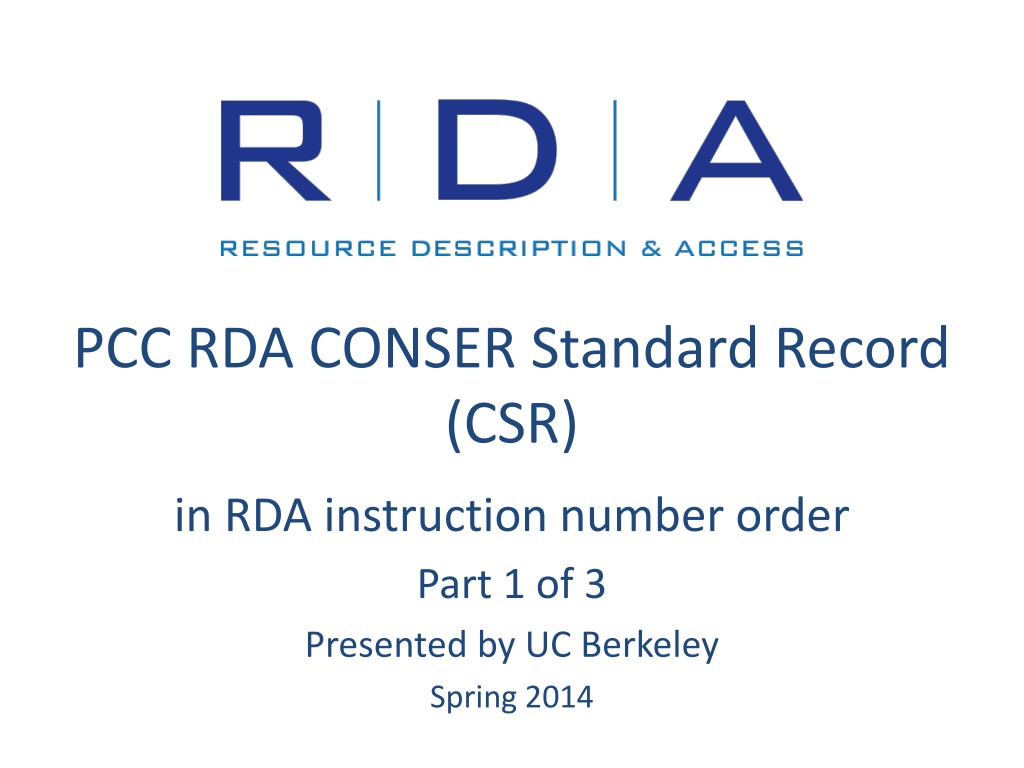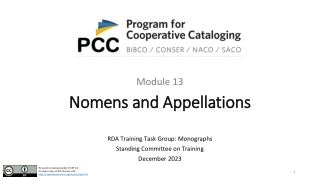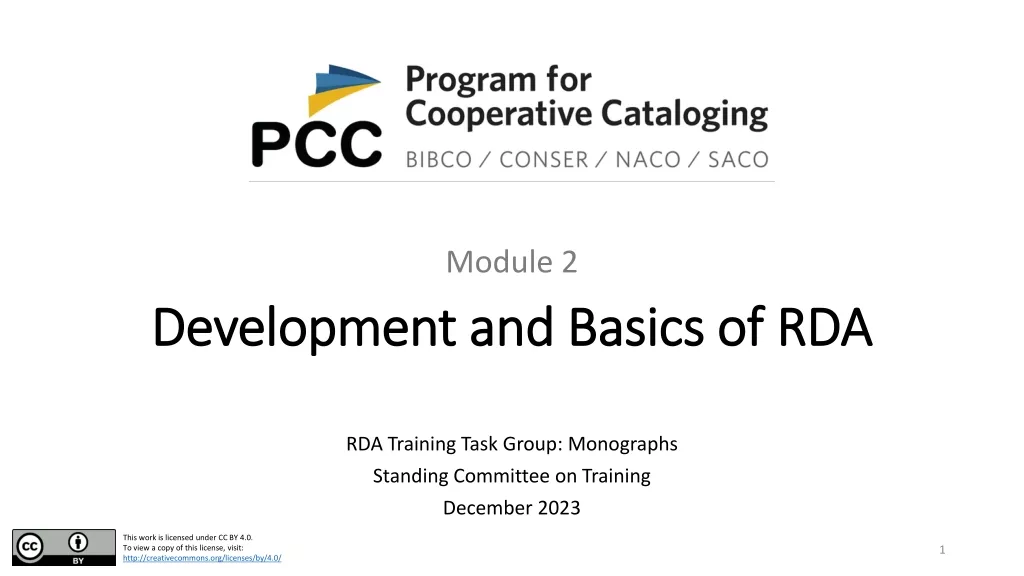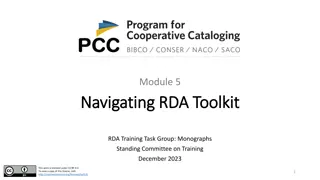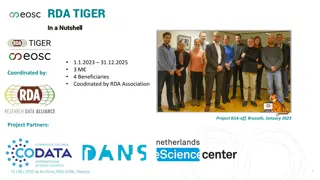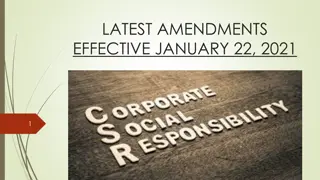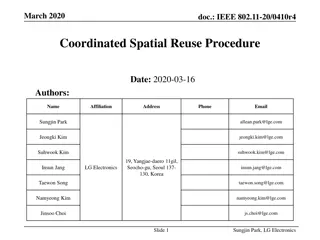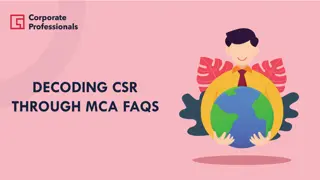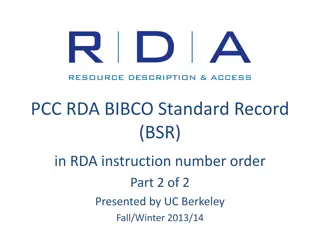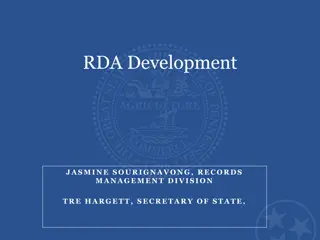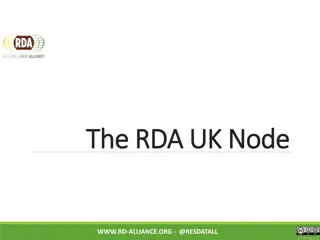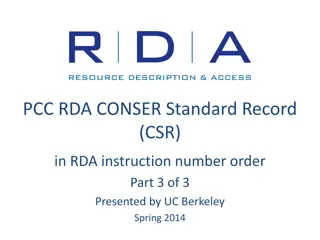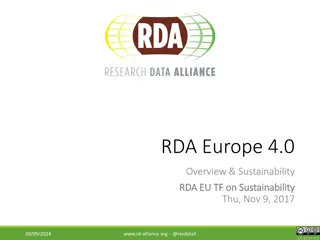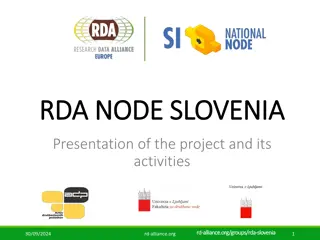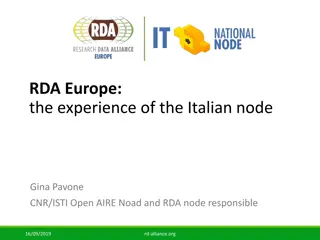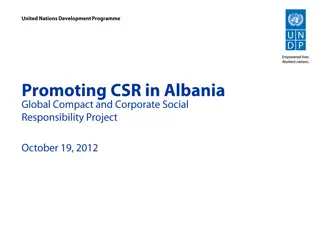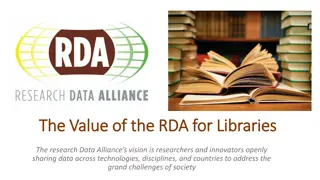Understanding CONSER Standard Record (CSR) in RDA Instructions
Explore the principles behind CONSER Standard Record (CSR) in RDA instructions through UC Berkeley's training materials. Learn how to apply CSR and UC Berkeley policy statements to describe textual serials and integrating resources in various formats. Discover the differences between AACR2 rules and RDA instructions for cataloging activities, and exercise judgment when reviewing existing catalog entries. Dive into the training overview, acronyms used, and current revisions being made to PCC/CONSER documentation for RDA.
Download Presentation

Please find below an Image/Link to download the presentation.
The content on the website is provided AS IS for your information and personal use only. It may not be sold, licensed, or shared on other websites without obtaining consent from the author. Download presentation by click this link. If you encounter any issues during the download, it is possible that the publisher has removed the file from their server.
E N D
Presentation Transcript
PCC RDA CONSER Standard Record (CSR) in RDA instruction number order Part 1 of 3 Presented by UC Berkeley Spring 2014
Learning Objectives Apply the CSR (PCC Core) and UC Berkeley Policy Statements to describe textual serials and integrating resources (non-rare) in several formats: print, online, tangible electronic, microform Distinguish substantive differences between AACR2 rules/AACR2 version of CCM & CSR and RDA instructions (plus local guidelines) for PCC Core elements Exercise appropriate judgment when reviewing and editing existing copy for the local catalog @ UCB 2
Training Overview Day 1 (today): CONSER/PCC Core elements in RDA Chapters 1-2 Day 2: CONSER/PCC Core elements in RDA Chapters 3-end Day 3: making changes/working with copy @ UCB 3
Acronyms CSR = CONSER Standard Record Library of Congress Program for Coop. Cat. Policy Statement (RDA equiv. of LCRI) UC Berkeley Policy Statement (local policy) integrating resource provider-neutral (PCC guidelines for cataloging online resources available from multiple providers) CONSER Cataloging Manual LC-PCC PS = UCB PS = IR = P/N = CCM = @ UCB 4
More Acronyms AAP = Authorized Access Point (RDA equiv. of heading ) Work, Expression, Manifestation, Item (FRBR Group 1 entities) Person, Family, Corporate body (FRBR Group 2 entities) Concept, Object, Event, Place (FRBR Group 3 entities) WEMI = PFC = COEP = @ UCB 5
PCC/CONSER Documentation Currently in force CONSER Standard Record (CSR) Metadata Application Profile Provider-Neutral E-Resource guide sort of: RDA Cataloging Checklist BIBCO Standard Record (BSR) for applicable PCC Core elements of any non-textual serials & IRs @ UCB 6
PCC/CONSER Documentation Being revised for RDA as we speak CONSER Cataloging Manual (CCM) 8 revised modules already published in Cataloger s Desktop; others underway Planned to be revised for RDA CONSER Editing Guide (CEG) @ UCB 7
@ UCB Image courtesy of Steve Shadle 8
RDA Toolkit organization: refresher Sect. 1: Manifestation and Item (MI) Sect. 2: Work and Expression (WE) (including AAPs (and authority records) for works and expressions) Sect. 3: Person, Family, Corporate Body (PFC) (FRBR Group 2): AAPs and authority records Sect. 4: Concept, Object, Event, Place (COEP) (FRBR Group 3): AAPs and authority records Sect. 5: Primary Relationships (relationship of a resource to itself at various WEMI levels) @ UCB 9
RDA Toolkit organization: refresher cont d Sect. 6: Relationships to PFCs (i.e. making name entries ) Sect. 7: Relationships to COEPs (i.e. assigning subject headings) Sect. 8: Relationships between WEMIs (relationship of a resource to a separate resource) Sect. 9: Relationships between PFCs (elements for name authority records) Sect. 10: Relationships between COEPs (elements for subject authority records) @ UCB 10
RDA Toolkit organization: refresher cont d Appendices a few key ones A: Capitalization I: Relationship Designators: resource to PFC (for use with Chapters 18-22) J: Relationship Designators: resource to resource (for use with Chapters 24-28) @ UCB 11
A walk through the CSR Mainly for serials; IRs mentioned in passing Most but not all listed elements are Core; be sure to read Notes Will look at elements or instructions not in CSR: very important and/or very different from AACR2 In RDA instruction order because MARC is going away @ UCB 12
Old CSR, New CSR Old CSR = AACR2 version Introduced in 2007 Anticipated some RDA changes, e.g.: Fewer required elements (i.e. fields) Appendix B (abbreviations) optional for some elements New CSR = RDA version Very similar to the AACR2 version Familiarity with the old head start on the new @ UCB 13
Significant Differences, Frequently Encountered Numbering: Numerals are not transcribed, rest of numbering is transcribed No more abbreviations Publication (etc.) statement(s): Transcribe data as it appears Sources of information Multiple statements for different kinds of data cont d @ UCB 14
Significant Differences, Frequently Encountered cont d Notes: No longer required to justify added entries Prefer machine-actionable data MARC 33X fields replace GMD AAP for the work (i.e. main entry ) must be unique This requirement went away with the Old CSR, now it s back @ UCB 15
Significant Differences, Less Frequently Encountered Edition statement Transcribe as it appears AAP for language editions Treat the same as translations in AAP ( heading ) Compilation of expressions Need analytical AAPs (title or name/title added entries ) @ UCB 16
Getting Started: Is it a serial? Is it an IR? No change from AACR2 Is it a serial? successive parts usually bears numbering no predetermined conclusion Is it an integrating resource? A resource that is added to or changed by means of updates that do not remain discrete but are integrated into the whole. @ UCB 17
Getting Started: When might a separate record be needed? Supplements, issued in parts, reprints, etc. no change from AACR2 see LC-PCC PS 0.0, section Determining Number of Records Changes in descriptive or identifying elements see RDA 1.6 cont d on next 2 slides @ UCB 18
Changes Requiring a New Description RDA 1.6 Serials: RDA 1.6.2 Mode of issuance Carrier characteristics (i.e. format/physical medium) Major change in title proper Responsibility when name of PFC is part of AAP for the work Edition statement signifying significant change in scope or coverage @ UCB 19
Changes Requiring a New Description RDA 1.6 Integrating Resources: RDA 1.6.3 Mode of issuance Media type Re-basing Edition statement signifying significant change in scope or coverage @ UCB 20
Basis for Identification of the Resource RDA 2.1 No change from AACR2 Serials: RDA 2.1.2.3, CCM 3.1 If issues are numbered: choose issue with the lowest number If issues are unnumbered: choose issue with the earliest issue date Integrating Resources: RDA 2.1.2.4 Choose the current iteration (i.e. latest) @ UCB 21
Transcription RDA 1.7 Capitalization: RDA 1.7.2 Prefer Appendix A Other guide/standard or take what you see acceptable in copy Punctuation: RDA 1.7.3 Transcribe as it appears, except when it separates elements on the source Diacritical Marks: RDA 1.7.4 Follow UCB PS 1.7.4: do not add when not present in source, except when necessary and known @ UCB 22
Transcription contd RDA 1.7 Abbreviations: RDA 1.7.8 Transcribe as found; do not abbreviate when not abbreviated in source Inaccuracies: RDA 1.7.9 Transcribe as found, unless specific instruction for element says otherwise BIG EXCEPTION for serials and IRs: for title proper, correct obvious errors; make a note indicating how title actually appears on source @ UCB 23
Numbers/Numerals RDA 1.8 Record numerals as they appear (UCB PS 1.8.2); record words as numerals (RDA 1.8.3) RDA 1.8 applies to many elements that are used in serials cataloging; see list at RDA 1.8.1 For any serial/series numbering: Term part is transcribed per 1.7 Number part is recorded per 1.8 @ UCB 24
Numbers/Numerals RDA 1.8 Examples: On source: VOLUME I, NUMBER 1 Record as: On source: Sexto Tomo Record as: @ UCB 25
Facsimiles and Reproductions RDA 1.11 For microform reproductions only: continue to follow LCRI 11 Describe the original; include details of the reproduction in a note (MARC 533) For other formats, best practices are still being worked out @ UCB 26
Sources of Information: Preferred Source RDA 2.2.2 Print, or any facsimile reproduction in any format: apply 2.2.2.2 First choice: title page If no title page, then hierarchy of choices a) cover or jacket b) caption c) masthead d) colophon If still no title, look at any other source within the resource Do not use square brackets @ UCB 27
Sources of Information: Preferred Source cont d RDA 2.2.2 Non-print (e.g. electronic, microform) When there are page images, apply 2.2.2.2 Otherwise, apply 2.2.2.4 Example: CD-ROM hierarchy of choices a) printing or label on disc surface b) textual content that presents a title c) container or accompanying material issued with the resource d) any other source forming part of the resource Do not use square brackets @ UCB 28
Sources of Information: Preferred Source cont d RDA 2.2.2 Serials: Retrospective cataloging: LC-PCC PS 2.2.2/CCM 3.2.3 no change from AACR2 Choose a stable title, even if from a less- preferred source If the title page is added to or dropped from issues, treat the resource as lacking a title page @ UCB 29
Sources of Information: Other Sources RDA 2.2.4 When to apply? When information does not appear within the resource for listed elements Look at in this order: a) accompanying material not part of the resource b) other published descriptions (e.g. Amazon.com) c) container not issued with the resource d) any other source (e.g. DLB, email from publisher) When applying, use square brackets (LC-PCC PS 2.2.4) @ UCB 30
Recording Titles RDA 2.3.1.4 UCB PS 2.3.1.4: may abridge a long title if it can be abridged without loss of essential information (see RDA 2.3.1.4 Optional Omission) Doesn t come up often with serials & IRs May be better not to abridge in some cases @ UCB 31
Recording Titles contd RDA 2.3.1.4 Exceptions to basic instruction Inaccuracies: must correct any obvious, inadvertent errors in title proper (no change from AACR2); may give erroneous title as a variant title as in RDA 2.17.2.4 @ UCB 32
Recording Titles contd RDA 2.3.1.4 Exceptionsto basic instruction cont d Date, name, number, etc., that varies from issue to issue: omit and use mark of omission Change from AACR2: use mark of omission anywhere within title (e.g. even at the beginning) On source: 2005/06 End of Session Report RDA: Record as: AACR2: @ UCB 33
Title Proper RDA 2.3.2 Means the same thing in RDA as in AACR2 No change from AACR2, except: transcribe as it appears per RDA 1.7 hierarchy of choices when title page lacking per RDA 2.2.2.2 Remember exceptions for retrospective cataloging: LC-PCC PS 2.2.2/CCM 3.2.3 may choose a different preferred source @ UCB 34
Title in More Than One Form RDA 2.3.2.5 See Exception: when title appears as both initialism/acronym and spelled-out form, choose spelled-out form as title proper Record initialism/acronym as variant title, not other title information On source: Linguistics and language behavior abstracts (LLBA) Record as: @ UCB 35
Parallel Title Proper RDA 2.3.3 Reminders: May take from any source within the resource May take from a source outside the resource IF that s where the title proper was taken from Must record in 246 Generally do not also record in 245$b (OK to accept in copy) @ UCB 36
Other Title Information RDA 2.3.4 Not actually PCC Core; see CSR Notes If included, must be taken from same source as title proper If it s not on the same source as title proper, then it s not other title information NEVER supply (other than for cartographic and moving image resources) If descriptive information is needed, give it as a note @ UCB 37
Variant Title RDA 2.3.6 Record any that a user might reasonably consider to be the title Can be taken from any source, even outside the resource UCB PS 2.3.6.3: follow Best Practices sections of LC-PCC PS 2.3.6.3 (e.g. spelling out abbreviations, symbols, numerals, etc.) cont d @ UCB 38
Variant Title contd RDA 2.3.6 Also record: Initialism/acronym when spelled-out version is recorded as title proper Erroneous title appearing on source when corrected title is recorded as title proper (construct as note with $i) P/N guidelines: any provider-specific title variants {Title} @ UCB 39
Earlier Title Proper RDA 2.3.7 Serials: use only for online serials where the title proper changes and all evidence of the earlier title is removed (LC-PCC PS 2.3.7.3) IRs: use whenever the title proper changes; record current title as title proper and move superseded title to earlier title proper (RDA 2.3.2.12.3) @ UCB 40
Later Title Proper RDA 2.3.8 No change from AACR2 For serials only, not IRs Record minor title changes No change from AACR2 in how major and minor title changes are defined or treated AACR2 21.2C2 = RDA 2.3.2.13 @ UCB 41
Abbreviated Title RDA 2.3.10 Not actually PCC Core Accept if found in copy and correctly recorded @ UCB 42
Statement of Responsibility Relating to Title Proper RDA 2.4.2 Not actually PCC Core Responsible PFCs not always named Often not the same over the life of the resource Alternatives to using s.o.r.: Issuing body note AAP with relationship designator (when name is established) @ UCB 43
Statement of Responsibility Relating to Title Proper cont d When to consider using anyway: To record usage for any name that is not established When needed to support user tasks (change from AACR2) If using, apply RDA 2.4 and relevant UCB PSs Only one statement (first recorded) is required May omit any but first name when there are more than three with the same function May include or omit honorifics, affiliations, etc. @ UCB 44
Exercises on titles @ UCB 45
Exercises on titles Example A Example B @ UCB 46
Exercises on titles cont d Example C Acceptable option (judgment call): Statement could go in Issuing body note instead @ UCB 47
Exercises on titles cont d Example D Acceptable to include: What about Other Title Information? Do not record in 245$b, because title proper can stand on its own May record in a note @ UCB 48
Exercises on titles cont d Example E Other possibilities to include: @ UCB 49
Exercises on titles cont d Example F @ UCB 50
